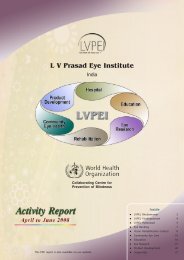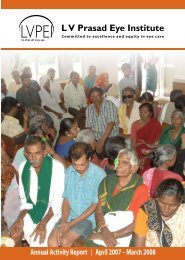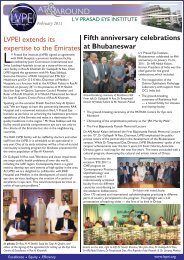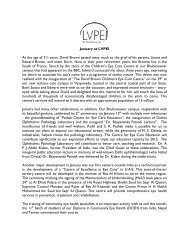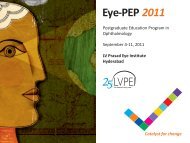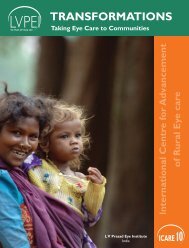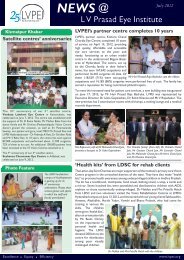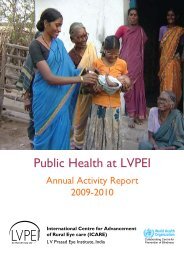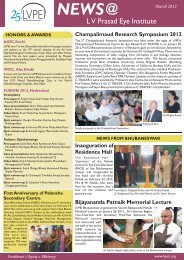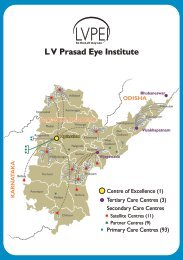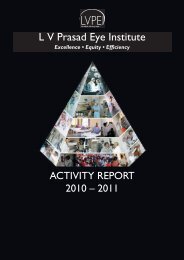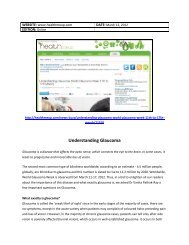IERG Abstracrt Book.indd - LV Prasad Eye Institute
IERG Abstracrt Book.indd - LV Prasad Eye Institute
IERG Abstracrt Book.indd - LV Prasad Eye Institute
Create successful ePaper yourself
Turn your PDF publications into a flip-book with our unique Google optimized e-Paper software.
Oral Presentation33Methods: 30 eyes of 15 rabbits were subjected to extracapsular cataract extraction and theregenerating lenses were obtained from animals at the end of 1, 3, 6, 9 and 12 months. Theselenses were processed to make paraffin sections. Serial sections were stained with periodicacid - Schiff-hematoxylin (PAS-H) and immunofluorescence of pax6-alpha smooth muscle actin(aSMA), PCNA and collagen I-collagen IV.Results: At one month, the regenerating lens can be divided into three regions, the centralregion containing only posterior thin capsule, circumferal region where the anterior andposterior capsule are in firm contact with each other and the peripheral region whereelongating lens fiber cells were present. The cells of circumferal region were positive to aSMAand extracellular material (ECM) positive to collagen I. At three months, the peripheral zoneenlarged due to formation of new lens fibers and aSMA positive cells were restricted toterminal junction of anterior and posterior capsule. At six months the anterior capsule loosecontact with the posterior capsule and at this place new envelop formed where cells werepositive to aSMA. At nine month, a new lobe developed adjacent to the larger lobe and itwas surrounded by envelope containing cells positive to aSMA. At 12 months, the new lobeenlarged further and was anteriorly covered by fibrous envelop which was positive to aSMA.The aSMA positive regions in 3, 6, 9 and 12 month were also positive to collagen I. The PCNApositive proliferative cells were located at regions positive to aSMA as well at the equatorialregions of each lobe.Conclusions: In regenerating rabbit lens, the EMT of lens epithelial cells may serve variety offunctions including synthesis of new envelop and providing an isolated area where regenerationof lens takes place.Paper Session II, Gene and Cell Based Therapy,July 31, 2010, 11.30-13.00 hrsChairs: S Krishna Kumar and Geeta K VemugantiIPT 007Characterization of Buccal Mucosal Epithelial Stem Cells and Evaluation of itsEfficacy in Corneal Surface ReconstructionC Gowri Priya, P Arpitha, T Lalitha, S Vaishali, NV Prajna, Kim Usha, VR MuthukkaruppanAravind Medical Research Foundation, Dr. G. Venkataswamy <strong>Eye</strong> Research <strong>Institute</strong>, Madurai,IndiaPurpose: To characterize stem cells (SCs) in buccal mucosal epithelium (BME) and to evaluatethe clinical efficacy of ex-vivo expanded autologous epithelium with known SC content incorneal surface reconstruction in patients with bilateral limbal stem cell deficiency (LSCD).Methods: The epithelial cells were isolated from 4x 2mm buccal biopsy and cultured onamnion in culture inserts with 3T3 feeder layer. The SCs were identified on the basis of ourtwo parameter analysis (Arpitha et al., 2005; 2008a, b), characterized for surface markers andcolony forming efficiency. The ex-vivo expanded autologous BME was transplanted onto cornealsurface in ten patients with LSCD. The clinical outcome was followed for a maximum of two



